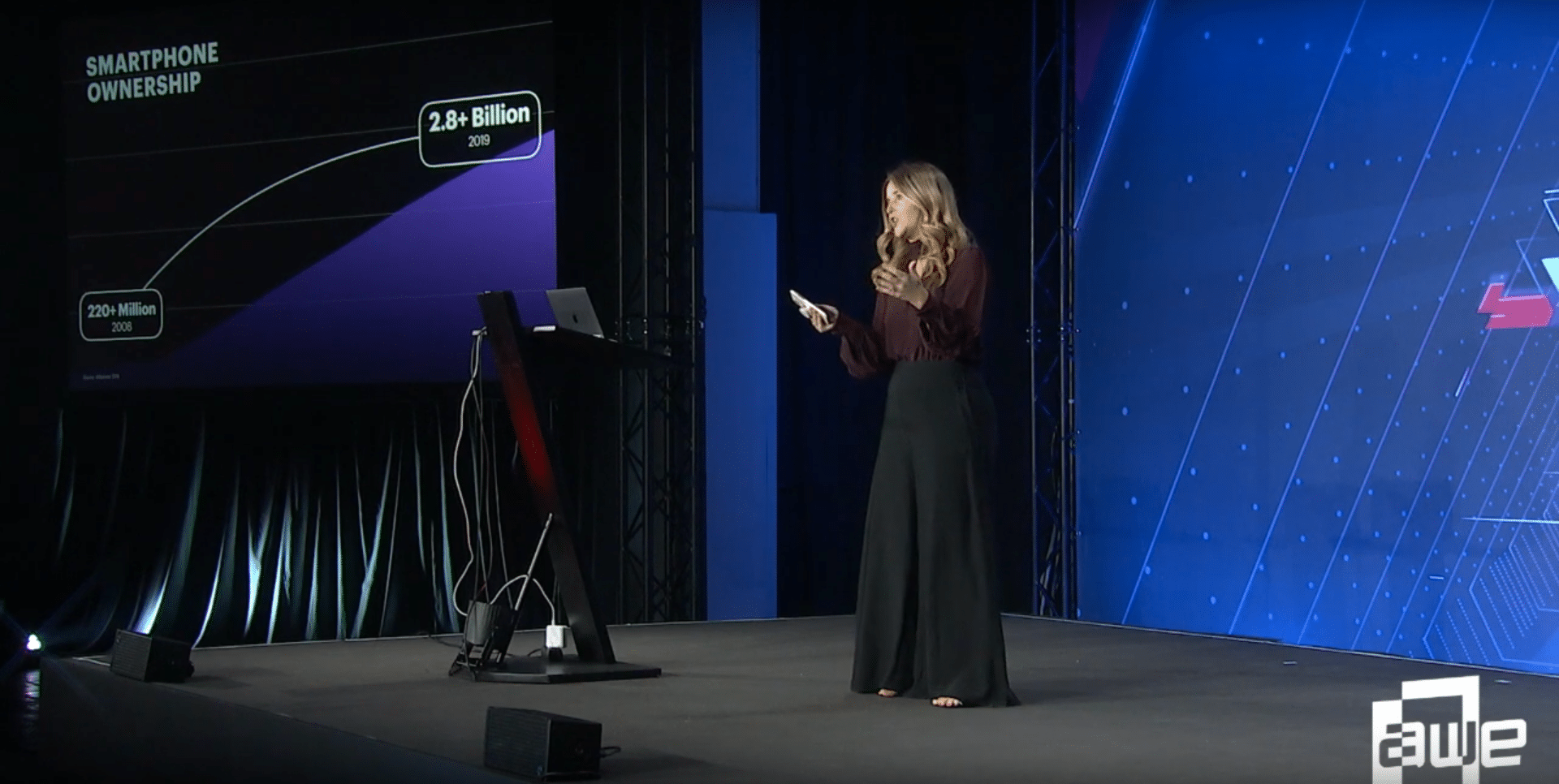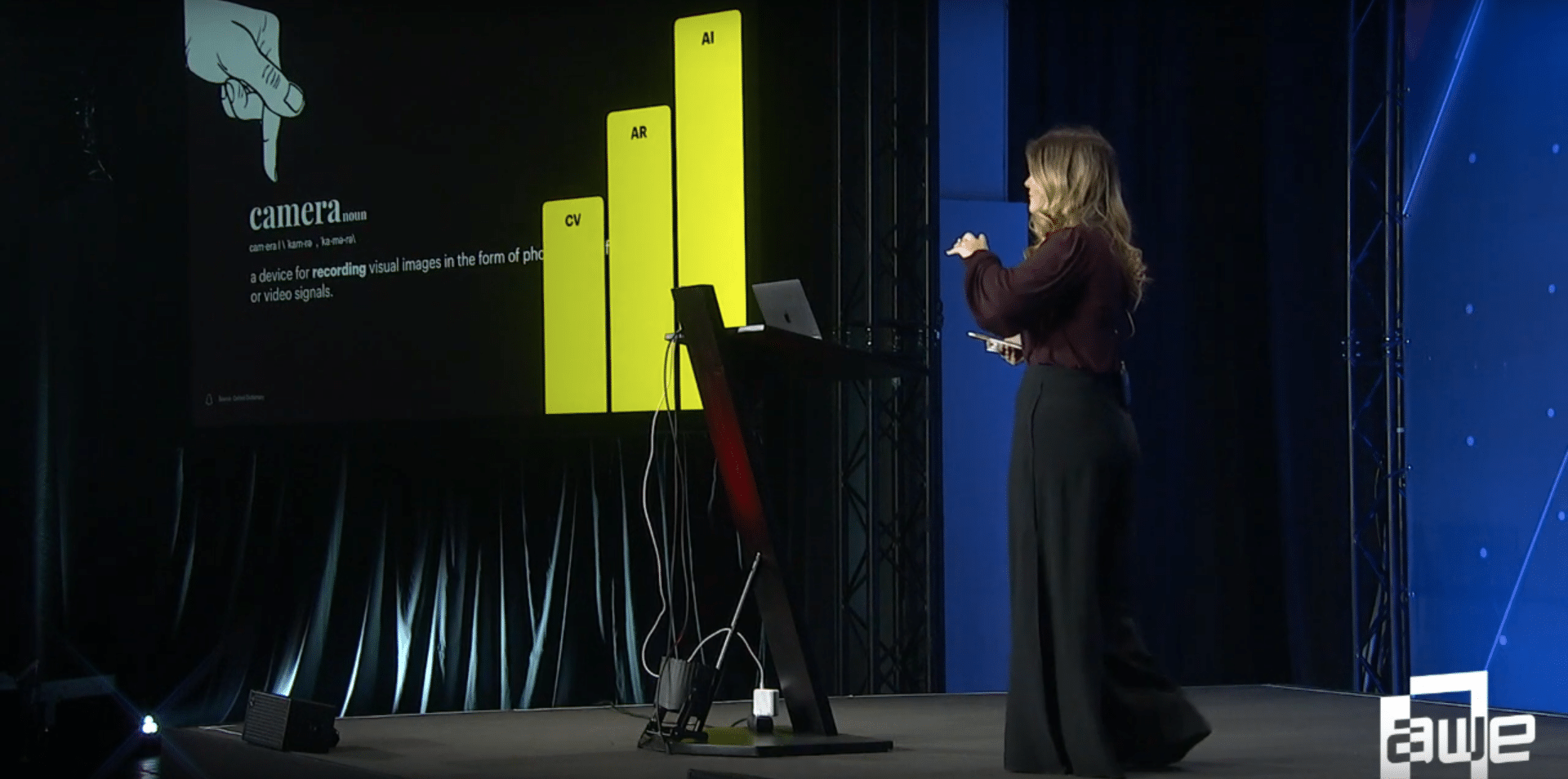
XR Talks is a series that features the best presentations and educational videos from the XR universe. It includes embedded video, as well as narrative analysis and top takeaways. Speakers’ opinions are their own. For a deeper indexed and searchable archive, subscribe to ARtillery PRO.
Snapchat currently holds the lead in active AR usage among consumer-AR providers. That includes more than 142 million daily active AR lens users, 15 billion lifetime lens engagements, and 500,000 lenses created. Snapchat users also activate AR lenses 30x per day on average.
Given that leading position, Snap’s tactics are ripe for examination to draw out transferable lessons. Just as we’ve mentioned in light of Pokemon Go, Snapchat is doing the AR industry a favor by large-scale experimentation to uncover user demand signals and formats that work.
Along those lines, Snap’s Carolina Arguelles gave a monster presentation at AWE Europe (video below) which we’ll cover in three parts. It’s packed with lessons for anyone working in AR product development, or consumer-facing brands that want to use AR to engage customers.

Camera-First
Much of Snap’s AR success traces back to its focus on the camera. This foundational principle makes Snap natively primed for AR. Beyond that groundwork, it’s executed well and leaned into AR as a core use case. Seeing financial results, it’s spent the last year doubling down on AR.
“Cameras have changed so much over the last few decades from this clunky hardware that you wear around your neck to basically a piece of software,” said Arguelles “It’s really the lens of a camera that gives you the window into human experience. It can connect the physical world with the power of the Internet… So our strategy and our focus with the camera is all about how we bring [it] into this new era and allow this future of computing overlaid of the world.”
To get there, Arguelles delineates three pillars of Snap’s AR strategy: Access, Adoption and Content. Starting with access, it’s all about mobile. Though Snap is planting seeds for a wearables future (more on that in part 2), the near term play is all about smartphone ubiquity.
“If you look at the change from 2008’s 220 million smartphone owners to today’s 2.8 billion, [that’s] a huge increase… The reason that’s important is because accessibility completely changed. And while we were talking about AR ten years ago, it didn’t come to life because actually being able to render AR from an everyday consumer standpoint was extremely difficult. But now everyone has a camera in the palm of their hand throughout the entire day.”

Camera-Forward
Further amplifying AR’s accessibility is the smartphone camera’s innovation cycles. It’s now arguably the main feature of today’s smartphones in terms of the marketing and points of differentiation in iPhones and Android’s flagship Pixel line. This lays the foundation for AR.
“The thing about Apple is that they don’t just have it as a feature, they prioritize the camera. If you look at just how the phone looks and the fact that there’s a shortcut to the camera, shows how the camera is prioritized. And when we think about consumer adoption of AR — and we know that the camera is the first step into getting into an AR experience — we need to prioritize how quickly someone can jump into that experience… That’s core to our platform. We say we’re a camera company, and what we mean is we believe the camera is more than taking photos… When you open up Snapchat, it opens straight to the camera.”
This may seem trivial but is a key component of Snapchat’s AR success. Camera access reduces friction in getting to AR, compared to other social media where it’s discovered in a feed. The result is 3.5 billion snaps per day, and 250 million minutes interacting with AR daily.
“It’s completely at odds with what you expect when you open up an app which is a feed — which we’ve been trained as people in the digital era. This UX of opening up straight into the camera just feels weird but it’s intentional… because we wanted the mindset within this app to be ‘camera-first’, to be ‘create-first,’ to be ‘look-around’ first… not ‘lean-back,’ and not just ‘consume.’”

Camera-Native
Moving on to the second pillar, adoption, Snap built AR around communication. That compares with AR use cases like gaming and product visualization. As we’ve examined, this is important because communication is inherently a high-frequency use case — a key AR success factor.
“All of those use cases are compelling, and I think a lot of companies have done a really good job paving the way… I love IKEA… but I don’t shop at IKEA every day. So when we think about this future that people talk about that AR is everywhere… in order to make that a reality, we have to focus on everyday needs… Communication is the key everyday need that we have decided to build around. [This] is what’s really led to the mass scale that we’re seeing today.”
Drilling down on communication, another factor in Snap’s AR success is leaning into visual messaging. This builds on the progression of phone calls to texting to rich-media. Millennials and Gen Z in particular communicate through images and emoji, rather than words.
“We like to call them the ‘camera-native generation’ because they were raised with the camera… They’re as comfortable with a camera as you are with a keyboard…That comfort level is so important to the future of AR really taking off… If you require people to be involved with the camera in order to unlock [AR], you want them comfortable… the underlying behavior shift needs to happen before everything else can layer on top. This generation is that generation… Eventually, more people will because it’s a richer form of communication.”
We’ll be back in Part II to go deeper on Snap’s third pillar of AR success: Content. That’s all about relevance and scale — not new success factors but ones that take on new life in the world of “camera marketing.” Part III will then cover tactical advice. Meanwhile, see the full talk below.
For deeper XR data and intelligence, join ARtillery PRO and subscribe to the free AR Insider Weekly newsletter.
Disclosure: AR Insider has no financial stake in the companies mentioned in this post, nor received payment for its production. Disclosure and ethics policy can be seen here.
Header image credit: AWE
